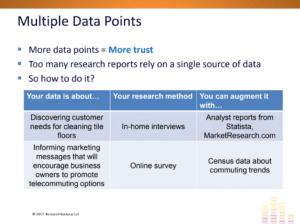Have you ever tried to change someone’s opinion? About anything? Whether it’s their opinion of a local restaurant or a national political figure, changing opinions is hard.
Humans naturally form opinions: this is a well-researched behavior. And as customer insights professionals, we sometimes have market research data that challenges our clients’ opinions about their brand, products or customers. Sometimes the data we deliver is different than what they expected…or hoped for. No wonder a lot of market research data doesn’t get used: all too often, we are trying to change opinions.
So, how can we get clients to pay attention to data that conflicts with their existing opinions? The best way to do it is by using multiple data points, from multiple sources. That’s how we make our research credible and trustworthy.
Activating Your Clients’ Use of Market Research Data
In this series, our president & lead instructor, Kathryn Korostoff, presents a three-part conversation on how to prevent clients from ignoring your data. She introduces three main solutions to this problem:
- Speaking the client’s language
- Using multiple data points
- Making results simple to apply
Part one elaborates on this first point; how speaking your client’s language can help keep your research results get used. If you missed the first part of this conversation, you can view it here.
Part two, summarized below, focuses on how using multiple data points helps build trust with your clients, and how this trust is crucial in keeping clients from ignoring your research results.
Using Multiple Data Points to Build Trust…And Change Opinions
Trying to change opinions based on the results from a single survey or set of focus groups is a hard task. It’s all too easy to challenge the research: maybe we didn’t survey the right people? Maybe the focus groups were biased by a dominant respondent? Maybe we didn’t ask the right questions? But if we can weave together multiple data points, from multiple sources, it is harder to ignore the results.
Sometimes we can achieve this by simply augmenting our primary research with some additional data sources. Consider the two simple examples in the figure here:

Even just supplementing the primary research results with relevant contextual data, we amp up our research’s credibility.
Of course, better still, is when we can leverage even more data sources. An increasingly common approach is to weave together analysis from ecommerce/customer databases (often for behavioral data) with primary research (often for attitudes and self-reported behaviors), into a single analysis and report. This blending of data sources into a single analysis has a much higher chance of being perceived as rigorous and credible, as compared to reports based on a single data source.
Often when we are asking people to use our research results, we are asking them to let us challenge their opinions. A very hard task, and one that is only achievable if they perceive our results as trustworthy.
________________________________
Thanks for reading! Check out the related video on Research Rockstar’s YouTube channel for more details as narrated by Kathryn Korostoff. Also, keep a look out for the third and final part of our conversation, where we will tackle the third solution: making your research simpler to apply!








